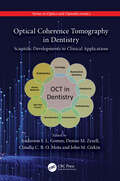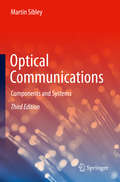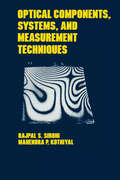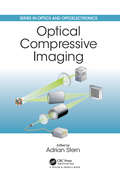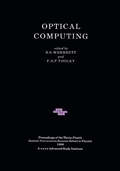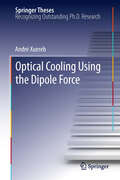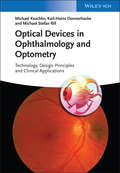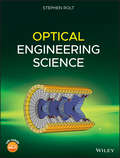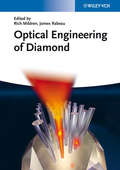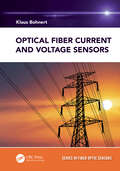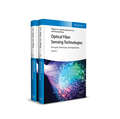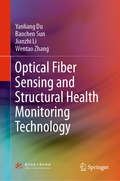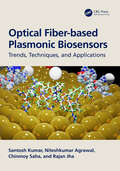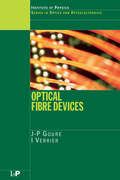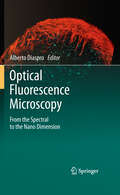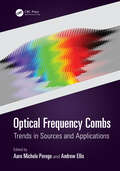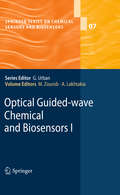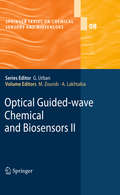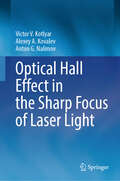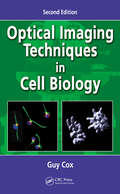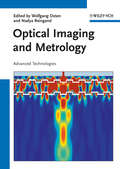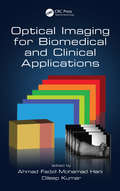- Table View
- List View
Optical Coherence Tomography in Dentistry: Scientific Developments to Clinical Applications (Series in Optics and Optoelectronics)
by Gomes, Anderson S. L.Optical Coherence Tomography (OCT), a method to "see inside of things" without destroying them, has been applied to subjects ranging from materials science to medicine. This book focuses on the biomedical application of OCT in dentistry, covering topics from dental materials to clinical practice. Since the introduction of the OCT method in ophthalmology in 1991, and then dentistry in 1998, developments in OCT methods, particularly in biomedical areas, have led to its dissemination worldwide. The chapters of this book cover the basics and recent global advances of OCT in dentistry, including an overview of the method and its use in cariology, restorative dentistry, dental materials, endodontics, pediatric dentistry, orthodontics, prosthodontics, soft oral tissues and nanodentistry. This book will be of interest to both newcomers in the field as well as those already working in OCT, either in research and/or the clinic. It will be of great use in courses on optical imaging applied to biomedical areas, particularly where it can provide real-life examples of the application of OCT.
Optical Coherence and Quantum Optics
by Leonard MandelThe advent of lasers in the 1960s led to the development of many new fields in optical physics. This book is a systematic treatment of one of these fields--the broad area that deals with the coherence and fluctuation of light. The authors begin with a review of probability theory and random processes, and follow this with a thorough discussion of optical coherence theory within the framework of classical optics. They next treat the theory of photoelectric detection of light and photoelectric correlation. They then discuss in some detail quantum systems and effects. The book closes with two chapters devoted to laser theory and one on the quantum theory of nonlinear optics. The sound introduction to coherence theory and the quantum nature of light and the chapter-end exercises will appeal to graduate students and newcomers to the field. Researchers will find much of interest in the new results on coherence-induced spectral line shifts, nonclassical states of light, higher-order squeezing, and quantum effects of down-conversion. Written by two of the world's most highly regarded optical physicists, this book is required reading of all physicists and engineers working in optics.
Optical Communications: Components and Systems
by Martin SibleyThe long-awaited third edition of this classic textbook provides a genuinely accessible introduction to the principles and technology of optical communication systems. It takes the reader from the fundamentals of light propagation in optical fibre, through materials and fabrication methods, light sources and modulation, to photodiodes and receiver design, and concludes with a chapter looking at system level integration.Updated throughout, major changes for this third edition include:- coverage of advanced semiconductor laser diode structures (VCSELs and DFBs)- an extended section on fibre amplifiers and lasers- updated discussion of avalanche photodiode structures- expanded coverage of transimpedance and optical preamplifiers- new sections on free-space optical links, VLC, ethernet links, coherent detection and terabit systemsEnhanced with worked examples and end-of-chapter problem sets, the book is aimed at advanced undergraduate and graduate students in electronic engineering, optical science and applied physics, and is ideally suited for adoption as a course text.
Optical Components, Techniques, and Systems in Engineering (Optical Science And Engineering Ser. #28)
by SirohiPresents optical techniques and measurement procedures, providing basic background information on optics and lasers, their components and basic systems. Contains information on thermal and laser sources, detectors, and recording materials, semi-conductor laser diodes, and optical techniques such as
Optical Compressive Imaging
by Adrian SternThis dedicated overview of optical compressive imaging addresses implementation aspects of the revolutionary theory of compressive sensing (CS) in the field of optical imaging and sensing. It overviews the technological opportunities and challenges involved in optical design and implementation, from basic theory to optical architectures and systems for compressive imaging in various spectral regimes, spectral and hyperspectral imaging, polarimetric sensing, three-dimensional imaging, super-resolution imaging, lens-free, on-chip microscopy, and phase sensing and retrieval. The reader will gain a complete introduction to theory, experiment, and practical use for reducing hardware, shortening image scanning time, and improving image resolution as well as other performance parameters. Optics practitioners and optical system designers, electrical and optical engineers, mathematicians, and signal processing professionals will all find the book a unique trove of information and practical guidance.
Optical Computing (Scottish Graduate Ser. #34)
by B.S. Wherrett; F.A.P. TooleyWritten by ten leading experts in the field, Optical Computing cover topics such as optical bistability, optical interconnects and circuits, photorefractive devices, spatial light modulators, associative memory, and optical computer architectures.
Optical Cooling Using the Dipole Force
by André XuerebThis thesis unifies the dissipative dynamics of an atom, particle or structure within an optical field that is influenced by the position of the atom, particle or structure itself. This allows the identification and exploration of the fundamental 'mirror-mediated' mechanisms of cavity-mediated cooling leading to the proposal of a range of new techniques based upon the same underlying principles. It also reveals powerful mechanisms for the enhancement of the radiation force cooling of micromechanical systems, using both active gain and the resonance of a cavity to which the cooled species are external. This work has implications for the cooling not only of weakly-scattering individual atoms, ions and molecules, but also for highly reflective optomechanical structures ranging from nanometre-scale cantilevers to the metre-sized mirrors of massive interferometers.
Optical Devices in Ophthalmology and Optometry: Technology, Design Principles and Clinical Applications
by Michael Kaschke Karl-Heinz Donnerhacke Michael Stefan RillMedical technology is a fast growing field. This new title gives a comprehensive review of modern optical technologies alongside their clinical deployment. It bridges the technology and clinical domains and will be suitable in both technical and clinical environments. It introduces and develops basic physical methods (in optics, photonics, and metrology) and their applications in the design of optical systems for use in medical technology with a special focus on ophthalmology. Medical applications described in detail demonstrate the advantage of utilizing optical-photonic methods. Exercises and solutions for each chapter help understand and apply basic principles and methods. An associated website run by the authors will include slides to facilitate the teaching/training of this material, and typical images collected by the described methods, eg videos of endoscopy or navigation, OCT, etc.
Optical Effects in Solids
by David B. TannerAn overview of the optical effects in solids, addressing the physics of various materials and their response to electromagnetic radiation. The discussion includes metals, semiconductors, superconductors, and insulators. The book begins by introducing the dielectric function into Maxwell's macroscopic equations and finding their plane-wave solution. The physics governing the dielectric function of various materials is then covered, both classically and using basic quantum mechanics. Advanced topics covered include interacting electrons, the anomalous skin effect, anisotropy, magneto-optics, and inhomogeneous materials. Each subject begins with a connection to the basic physics of the particular solid, after which the measurable optical quantities are derived. It allows the reader to connect measurements (reflectance, optical conductivity and dielectric function) with the underlying physics of solids. Methods of analysing experimental data are addressed, making this an ideal resource for students and researchers interested in solid state physics, optics, and materials science.
Optical Engineering Science
by Stephen RoltA practical guide for engineers and students that covers a wide range of optical design and optical metrology topics Optical Engineering Science offers a comprehensive and authoritative review of the science of optical engineering. The book bridges the gap between the basic theoretical principles of classical optics and the practical application of optics in the commercial world. Written by a noted expert in the field, the book examines a range of practical topics that are related to optical design, optical metrology and manufacturing. The book fills a void in the literature by coving all three topics in a single volume. Optical engineering science is at the foundation of the design of commercial optical systems, such as mobile phone cameras and digital cameras as well as highly sophisticated instruments for commercial and research applications. It spans the design, manufacture and testing of space or aerospace instrumentation to the optical sensor technology for environmental monitoring. Optics engineering science has a wide variety of applications, both commercial and research. This important book: Offers a comprehensive review of the topic of optical engineering Covers topics such as optical fibers, waveguides, aspheric surfaces, Zernike polynomials, polarisation, birefringence and more Targets engineering professionals and students Filled with illustrative examples and mathematical equations Written for professional practitioners, optical engineers, optical designers, optical systems engineers and students, Optical Engineering Science offers an authoritative guide that covers the broad range of optical design and optical metrology topics and their applications.
Optical Engineering of Diamond
by James Rabeau Rich MildrenThis is the first comprehensive book on the engineering of diamond optical devices. Written by 39 experts in the field, it gives readers an up-to-date review of the properties of optical quality synthetic diamond (single crystal and nanodiamond) and the nascent field of diamond optical device engineering. Application areas covered in detail in this book include quantum information processing, high performance lasers and light sources, and bioimaging. It provides scientists, engineers and physicists with a valuable and practical resource for the design and development of diamond-based optical devices.
Optical Fiber Current and Voltage Sensors (Series in Fiber Optic Sensors)
by Klaus BohnertOptical Fiber Current and Voltage Sensors is the first book to provide a complete, comprehensive and up to date treatment of the domain of fiber optic and polarimetric sensors, covering fundamental operating principles, characteristics, and construction. Written by one of the most recognised experts in polarimetric sensing, Optical Fiber Current and Voltage Sensors begins by covering the fundamentals of polarized light, as well as essential sensor components. The author then goes on to outline various sensor types and their applications, with a focus on sensors for electric phenomena. The chapters then lay out the demands that sensors need to meet, the technical obstacles and limitations which need to be considered. The book also covers comparisons to corresponding traditional instruments, as well as covering alternative non-conventional sensors. This book will be of interest to a broad audience of prospective readers ranging from graduate research students, to researchers in physics and engineering fields, to industry professionals active in the field who wish to learn about the technology and/or are interested in the development of new commercial solutions based on polarimetric-type fiber sensing as well as their use for high voltage current and voltage sensing.
Optical Fiber Sensing Technologies: Principles, Techniques and Applications
by Shuang Wang Kun Liu Tiegen Liu Junfeng JiangOptical Fiber Sensing Technologies Explore foundational and advanced topics in optical fiber sensing technologies In Optical Fiber Sensing Technologies: Principles, Techniques, and Applications, a team of distinguished researchers delivers a comprehensive overview of all critical aspects of optical fiber sensing devices, systems, and technologies. The book moves from the basic principles of the technology to innovation methods and a broad range of applications, including Bragg grating sensing technology, intra-cavity laser gas sensing technology, optical coherence tomography, distributed vibration sensing, and acoustic sensing. The accomplished authors bridge the gap between innovative new research in the field and practical engineering solutions, offering readers an unmatched source of practical, application-ready knowledge. Ideal for anyone seeking to further the boundaries of the science of optical fiber sensing or the technological applications for which these techniques are used, Optical Fiber Sensing Technologies: Principles, Techniques, and Applications also includes: Thorough introductions to optical fiber and optical devices, as well as optical fiber Bragg grating sensing technology Practical discussions of Extrinsic-Fabry-Perot-Interferometer-based optical fiber sensing technology, acoustic sensing technology, and high-temperature sensing technology Comprehensive explorations of assemble free micro-interferometer-based optical fiber sensing technology In-depth examinations of optical fiber intra-cavity laser gas sensing technology Perfect for applied and semiconductor physicists, Optical Fiber Sensing Technologies: Principles, Techniques, and Applications is also an invaluable resource for professionals working in the semiconductor, optical, and sensor industries, as well as materials scientists and engineers for measurement and control.
Optical Fiber Sensing and Structural Health Monitoring Technology
by Wentao Zhang Yanliang Du Baochen Sun Jianzhi LiThis book focuses on optical fiber sensing and structural health monitoring technologies. It provides detailed information on the basic theory of F-P optical fiber sensors, fiber Bragg grating sensors, fiber laser grating sensors and fully distributed optical fiber sensors. Drawing on the authors’ research achievements and many years of practical experience in the field of engineering structure health monitoring, the book elaborates on the structural principle, design and manufacture of optical fiber sensors and monitoring technologies, and briefly describes advances made with regard to multiple engineering structures.
Optical Fiber-based Plasmonic Biosensors: Trends, Techniques, and Applications
by Santosh Kumar Chinmoy Saha Niteshkumar Agrawal Rajan JhaThis book discusses the history, physics, fundamental principles, sensing technologies, and characterization of plasmonic phenomenon-based fiber-optic biosensors, using optic-plasmonic sensors as a case study. It describes the plasmonic phenomenon and its application in optical fiber-based sensing, presented based on properties and usage of different nanomaterials spread across nine chapters. Content covers advances in nanomaterials, structural designing, and their scope in biomedical applications. Future developments of biosensing devices and related articulate methods are also described. Features: Gives a comprehensive view on the nanomaterials used in plasmonic optical fiber biosensors. Includes synthesis, characterization, and usage for detection of different analytes. Discusses trends in the design of wavelength-based optical fiber sensors. Reviews micro- and nanostructured biosensing devices. Explores application of plasmonic sensors in the biosensing field. This book is aimed at researchers and graduate students in Optical Communications, Biomedical Engineering, Optics, Sensors, Instrumentation, and Measurement.
Optical Fibre Devices (Series in Optics and Optoelectronics)
by J.P Goure I VerrierThis book reflects the substantial progress made in the area of optical fibers and provides for the first time a systematic description of linear and non-linear fiber devices, including fiber couplers, splices, connectors, multiplexers, switches, and modulators. Primarily aimed at advanced undergraduate and graduate students in optics, optoelectron
Optical Fluorescence Microscopy
by Alberto DiasproIn the last decade, fluorescence microscopy has evolved from a classical "retrospective" microscopy approach into an advanced imaging technique that allows the observation of cellular activities in living cells with increased resolution and dimensions. A bright new future has arrived as the nano era has placed a whole new array of tools in the hands of biophysicists who are keen to go deeper into the intricacies of how biological systems work. Following an introduction to the complex world of optical microscopy, this book covers topics such as the concept of white confocal, nonlinear optical microscopy, fluctuation spectroscopies, site-specific labeling of proteins in living cells, imaging molecular physiology using nanosensors, measuring molecular dynamics, muscle braking and stem cell differentiation.
Optical Fluorescence Microscopy: From the Spectral to the Nano Dimension
by Alberto DiasproIn the last decade, fluorescence microscopy has evolved from a classical “retrospective” microscopy approach into an advanced imaging technique that allows the observation of cellular activities in living cells with increased resolution and dimensions. A bright new future has arrived as the nano era has placed a whole new array of tools in the hands of biophysicists who are keen to go deeper into the intricacies of how biological systems work. Following an introduction to the complex world of optical microscopy, this book covers topics such as the concept of white confocal, nonlinear optical microscopy, fluctuation spectroscopies, site-specific labeling of proteins in living cells, imaging molecular physiology using nanosensors, measuring molecular dynamics, muscle braking and stem cell differentiation.
Optical Frequency Combs: Trends in Sources and Applications
by Auro Michele Perego and Andrew D. Ellis“Optical Frequency Combs: Trends in Sources and Applications” offers an overview of the recent advances on the physics, sources, and applications of optical frequency comb technology – one of the most exciting and fast developing research fields in photonics.The book aims at showcasing recent advances through contributions by key players in a multifaceted research ecosystem, and at the same time at providing a valuable service to the community, by offering an as much comprehensive as possible review which, at the same time, highlights challenges to be solved and promising future directions.The main topics covered include: (i) an overview of different platforms for optical frequency combs generation as fibre lasers, quantum cascade lasers, integrated microresonators and waveguides, fibre resonators, electro-optic modulators and nonlinear fibres, multicore fibres; (ii) a selection of applications in different technologies including sensing, spectroscopy, precision metrology and optical clocks, microscopy, radio-frequency generation, distance ranging, and optical communications; (iii) a diverse range of physical methods for frequency comb generation such as modulation, laser mode-locking techniques, dissipative solitons and parametric gain in nonlinear resonators, nonlinear spectral broadening and supercontinuum formation in waveguides.This book will be a valuable resource for academics, researchers, and postgraduate students working and interested in the field optical frequency combs, and more broadly in photonic technologies too.Key Features:· Edited by authorities in the field, with chapter contributions from subject area leading experts in academia and industry.· Up-to-date with the latest technological developments, applications, and fundamental research from the field.· Describes comb properties depending on source and generation platform, and comb specifications matching to application needs.
Optical Guided-wave Chemical and Biosensors I
by Mohammed Zourob Akhlesh LakhtakiaFor the first time, distinguished scientists from key institutions worldwide provide a comprehensive approach to optical sensing techniques employing the phenomenon of guided wave propagation for chemical and biosensors. This includes both state-of the-art fundamentals and innovative applications of these techniques. The authors present a deep analysis of their particular subjects in a way to address the needs of novice researchers such as graduate students and post-doctoral scholars as well as of established researchers seeking new avenues. Researchers and practitioners who need a solid foundation or reference will find this work invaluable. This first of two volumes contains eight chapters covering planar waveguides for sensing, as well as sensing techniques based on plasmonic waveguides.
Optical Guided-wave Chemical and Biosensors II
by Mohammed Zourob Akhlesh LakhtakiaFor the first time, distinguished scientists from key institutions worldwide provide a comprehensive approach to optical sensing techniques employing the phenomenon of guided wave propagation for chemical and biosensors. This includes both state-of the-art fundamentals and innovative applications of these techniques. The authors present a deep analysis of their particular subjects in a way to address the needs of novice researchers such as graduate students and post-doctoral scholars as well as of established researchers seeking new avenues. Researchers and practitioners who need a solid foundation or reference will find this work invaluable. This second of two volumes covers the incorporation of periodic structures in waveguides to exploit the Bragg phenomenon, optical fiber sensors, hollow waveguides and micro-resonators as well as a review of the tremendous expansion of terahertz technology for sensing applications.
Optical Hall Effect in the Sharp Focus of Laser Light
by Victor V. Kotlyar Alexey A. Kovalev Anton G. NalimovThis book explores the optical Hall effect in the sharp focus of laser light. It builds upon the established theory of Richards-Wolf (1959), providing numerous real-world examples that illustrate both spin and orbital Hall effects near the focal point. Within the focal zone, distinct regions of left and right circular polarization emerge, showcasing the orbital Hall effect. This effect becomes apparent when localized areas within the focal plane experience transverse energy flow, rotating either clockwise or counterclockwise. The spin Hall effect, a fundamental occurrence, is demonstrated when a linearly polarized Gaussian beam is concentrated. Furthermore, the book reveals spin and orbital Hall effects in light fields with nonuniform linear polarization, where the polarization direction varies within the beam cross section. While the optical or photonic Hall effect has been recognized since 2004, a comprehensive monograph detailing its focal dynamics has been lacking until now. Drawing from the cohesive theoretical framework of the Richards-Wolf theory, this book offers specific examples and results from computer modeling. It equips readers with analytical relations for calculating energy and spin fluxes near a sharp focus across various initial light vector fields. Designed for a diverse audience, including scientists, engineers, and students in optics and photonics, this book serves as a valuable resource. It caters to undergraduate and graduate students in applied mathematics, physics, informatics, and optics, and can also benefit researchers and professionals in the field. Moreover, the book holds potential as a foundational text for advanced graduate courses
Optical Imaging Techniques in Cell Biology
by Guy CoxOptical Imaging Techniques in Cell Biology, Second Edition covers the field of biological microscopy, from the optics of the microscope to the latest advances in imaging below the traditional resolution limit. It includes the techniques-such as labeling by immunofluorescence and fluorescent proteins-which have revolutionized cell biology. Quantitat
Optical Imaging and Metrology: Advanced Technologies
by Nadya Reingand Prof. Dr. Wolfgang OstenA comprehensive review of the state of the art and advances in the field, while also outlining the future potential and development trends of optical imaging and optical metrology, an area of fast growth with numerous applications in nanotechnology and nanophysics. Written by the world's leading experts in the field, it fills the gap in the current literature by bridging the fields of optical imaging and metrology, and is the only up-to-date resource in terms of fundamental knowledge, basic concepts, methodologies, applications, and development trends.
Optical Imaging for Biomedical and Clinical Applications
by Ahmad Fadzil Mohamad Hani and Dileep KumarOptical imaging is a rapidly emerging imaging technique that has been successfjully translated into biomedical applications ranging from clinical diagnosis to molecular biology. This book includes an introductory section to explore various optical imaging devices and their functionality and roles for biomedical applications such as dermatology and ophthalmology. Recent developments as exemplified with the authors research are explored in detail. In depth discussion of other disease conditions and their diagnosis with optical imaging techniques are also covered.
